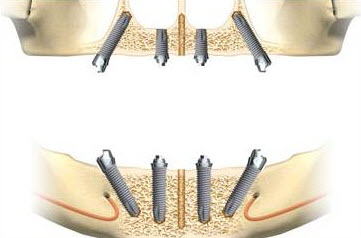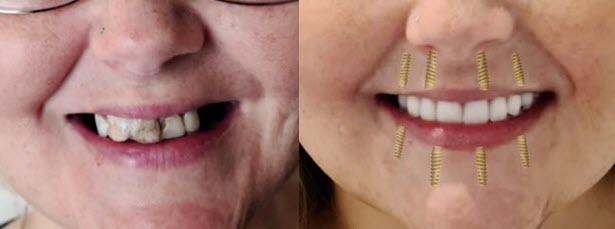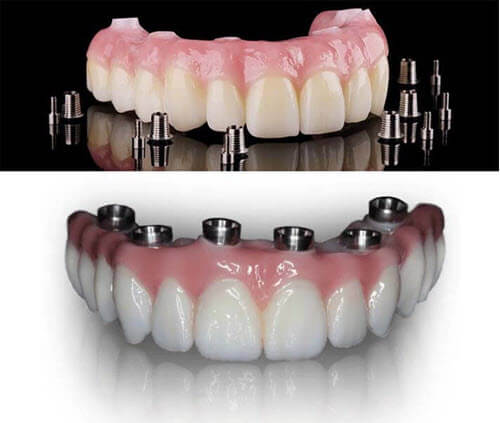GENERAL MENU
What Is The All-On-4 Dental Implants Treatment?
How Does The All On 4 Dental Implants Works?
Over the years, the All-On-4 implant treatment has developed as a concept. It is the best solution for people who need full-mouth implants on their upper or lower teeth.
Four implants are surgically placed on the upper jawbone. The implants are placed in an angled position, or where you have a greater bone density.


All-On-4. As it is the best option for patients that have no teeth left. All-On-4 Dental Implants are the best upgrade you can get. The treatment offers many benefits.
How Can I Tell if I'm a Suitable Candidate For The All-On-4

WHO IS AND WHO IS NOT A CANDIDATE FOR THE ALL-ON-4 DENTAL IMPLANTS
To place an implant, you need to have enough bone to support the post. Good dental implant osseointegration requires bone density. If you are missing several teeth or wear ordinary dentures, the All-On-4 is a suitable option for the following scenarios:
- People who are missing most of their teeth and are tired of 'patching' temporary fixtures only make you spend money.
- People who wear ordinary dentures often feel frustrated, self-conscious, depressed, and unable to eat properly.
Who is not a suitable candidate for all-on-4 dental implants?
- People with advanced bone recession issues.
- People with severe periodontal disease or untreated bone infections are at risk.
- Patients who have received radiation therapy within the last five years.
- Uncontrolled or unsupervised diabetes may not be eligible for dental implants.
- Smokers who are unwilling to quit will likely experience implant failure.
Are The All On Four Dental Implants Removable?

The Zirconia Superstructure is a non-removable; palate-less fixed bridge.
SECOND STAGE COST (Second trip to Cancun)
Six months after the surgery where the implants were set, we can now set the final structures. There are three ways to finish your treatment.
OPTION 1 (PRICE PER ARCH)
CAD/CAM Milled Zirconia Prettau Bridge
US 6,100 US 5,500 LIMITED TIME OFFER
OPTION 2 (PRICE PER ARCH)
Fixed Hybrid bridge with a titanium bar
US 6,000 US 5,000 LIMITED TIME OFFER
OPTION 3 (PRICE PER ARCH)
Snap-on Mechanism
US 3,200 US 2,500 LIMITED TIME OFFER
All On Four Dental Implants Benefits
Despite the advances in dentistry, many people still suffer from overdentures, restorations, or porcelain bridges; for many years, that was the only option for people with missing teeth.
Dental Implants Provide a Safe and Healthy Alternative
The benefits of any implant solution, such as the All-On-4, go beyond a supportive role.
Implants promote the blood flow in the gums. They will preserve the health of your jawbone and may decrease the amount of bone resorption.
There are many benefits you can get from a tooth implant procedure.
1. NO MORE DISCOMFORT
There is no discomfort at all from having implants in the bone. The titanium screw becomes a part of the bone through the osseointegration process. The body's natural cycle is when the bone fuses with the titanium post.
Titanium is a noble material that usually blends well with human bone and is rarely rejected by human tissue.
As the tooth implant becomes part of your jawbone or maxilla, the inconvenience of standard dentures becomes part of the past.
The process and anatomy inside a human jawbone. This is how the implant post works in the jawbone.
2. IMPROVE YOUR APPEARANCE
On top of each titanium screw, there will be a crown. To the exterior, the only view would be the crown on top that resembles the rest of your teeth.
The final result of dental implants will look and feel like your natural teeth. They will fuse to your jawbone without worrying about losing it while you eat or speak. On the exterior view, people will see a beautiful restoration like a crown or a fixed hybrid denture.
There is no need to have teeth missing. You can restore your smile with the following:
The single-tooth implant procedure
Implant bridge
All-On-Four
All-On Six
3. ALL YOU CAN EAT!
Dental implants will restore your biting functions. As implants will recover your chewing process, you can eat all the foods you want.
When most teeth are missing, you must depend on dentures that slide or wiggle, making eating difficult.
Your food choices are vast again. Now you can eat again. The same way (or even better) as when you had your natural teeth! And as with much confidence as before losing that tooth.
4. FEEL CONFIDENT WHILE YOU SPEAK
With full mouth implants, you will restore your speaking abilities.
The implants will support the fixed bridge, giving you confidence while speaking. Slurring or mumbling out your words will be part of the past!
5. GET RID OF DENTURE GLUE
Standard dentures require effective denture glue to try to avoid slippage. With full-mouth dental implants, you will exclude the need for dental glue.
Denture adhesive can also cause secondary side effects, such as stomach problems, as the constant ingestion of dental glue cannot be avoided.
Also, not all denture adhesives are effective and could fail you, losing your denture while you eat or speak.
6. RECOVER THE SELF ESTEEM
Your confidence and self-esteem will boost when you recover your smile.
You could even avoid social gatherings, frightened of an embarrassing moment.
Looking great with a new smile can change your life as you feel good and confident about your looks.
7. CONFIDENCE FOR A LIFETIME
Once implants are set into your jawbone, they become your responsibility.
They can last for a long time, maybe even a lifetime. But, the excellent care of those implants will be entirely on your side.
Your daily oral hygiene habits must include brushing, mouthwash, and Waterpik.
With the proper hygiene and care, the titanium screw can last in your jawbone for a lifetime.
The rates of successful placement depend on the position of the implant and the patient's habits. The regular success rate of the post-placement is 98%, while it's reduced to 70% in smokers.
8. COST-EFFECTIVE TREATMENT
Eventually, placing dental implants becomes the most cost-effective solution.
Missing teeth can cause several jaw problems, such as bone shrinkage, which may cause later problems that will need other solutions, like a bone graft or sinus lift.
Full mouth implants will help you restore your mouth functions, avoiding any problems in the future concerning your oral health.
9. IMPROVE YOUR HEALTH
With All On 4, you will improve your oral health. You will be able to bite and chew foods better, and you can include foods you couldn't eat before and get the proper nutrients you need. Also, when you chew properly, your stomach health can be restored.
When you chew properly, your stomach health is restored.
You will avoid affecting the adjacent teeth with a single-tooth implant procedure. An implant bridge does not need any shaving of the adjacent teeth, as a tooth-supported bridge does.
With implants, you preserve your long-term oral health.
All-On-4 Frequently Asked Questions
After surgery, you could feel mild discomfort, and swelling is addressed with analgesics and antibiotics. If the patient takes the medication, it should not hurt.
We recommend avoiding heavy exercise and smoking during the first couple of weeks after the surgery. Smoking through dental implant recovery could affect adequate healing.
All On 4 Cancun

DON'T BE SHY. GET IN TOUCH TODAY!
CALL US TOLL-FREE 1888-818-6328
